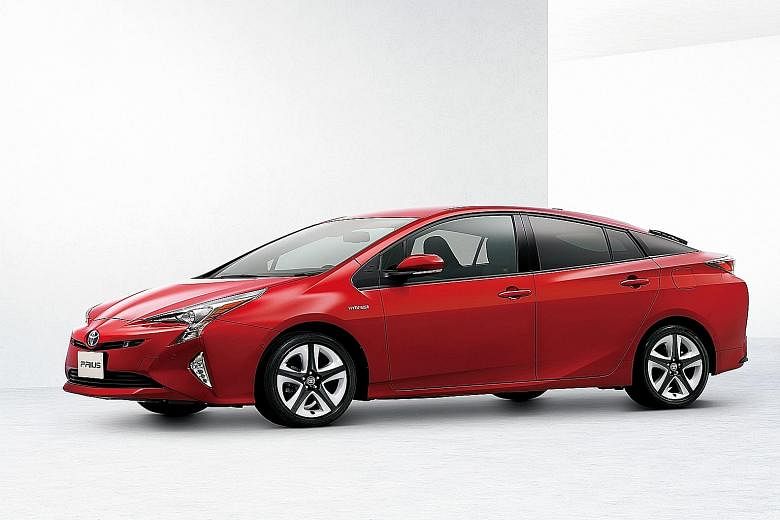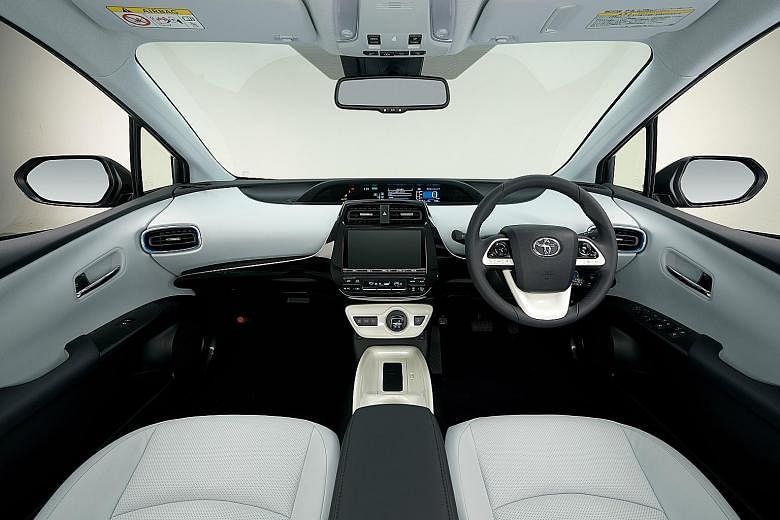For the past 18 years and across three model generations, the Toyota Prius has been the poster car for eco-motoring.
The fourth-generation model is likely to be the same, thanks to even greener performance made possible by state-ofthe-art hybrid technology.
But this time, Toyota has tried to make the Prius less geeky and more funky. When chief engineer Koji Toyoshima introduced key points of the new car, "excellent fuel economy" was third on the list after "fun to drive" and "eye-catching design".
The newcomer's exterior is quite a sight indeed. There are hints of the radical Mirai, Toyota's new hydrogen fuel-cell car. Its integrated rear spoiler is neat and the red LEDs in the tail-lamps look dramatic when lit.
The dimensions and proportions have changed dramatically too. The new Prius is 60mm longer, 15mm wider and 20mm lower, while the plunging roof profile, rising belt line and black C-pillars create a "teardrop" glasshouse.
-
TOYOTA PRIUS 1.8
Price: To be announced
Engine: 1,797cc 16-valve inline-4 with motor assist
Transmission: Continuously variable transmission
Power: 98bhp at 5,200rpm
Torque: 142Nm at 3,600rpm
0-100kmh: 11 seconds
Top speed: 180kmh (estimated)
Fuel consumption: 2.5 litres/100km
Agent: Borneo Motors
The Prius' nose is now so low (70mm lower than before) that its Toyota badge is at the same height as the one on the Toyota 86 coupe.
The car's coefficient of drag has also been lowered to 0.24, marginally better than its predecessor's 0.25, but otherwise offers not much of an advantage outside a wind tunnel.
Inside the cabin, both space and comfort have been improved, but the latter is more noticeable thanks to well-cushioned seats, welldistributed air-conditioning and an unusual silence once you shut the doors.
This is the quietest Prius yet, with little outside noise intruding from the windows, wing mirrors and fender areas. My ears tell me this Toyota "sounds" like the inside of the refined Lexus IS.
Credit goes to the Prius' tighter body structure, with its greater proportion of high-strength steel and more laser-welded points, plus additional noise-absorbing/insulating materials under the floorboard and around the dashboard.
Mechanically, there are significant improvements to the proven 1.8-litre petrol-electric drivetrain.
The engine has a diesel-like thermal efficiency (productive combustion relative to wasted heat) of 40 per cent, up from 38.5 per cent.
Also, the mechanical loss of the hybrid transmission has been reduced by 20 per cent, the high-output motor is 20 per cent lighter and the power control unit is more than 30 per cent smaller, yet more efficient.
Furthermore, the nickel-metal hydride battery pack has been downsized (1kg lighter and 10 per cent smaller) and its charging efficiency has improved by almost 30 per cent.
The downsizing of the battery pack has allowed it to be repositioned from behind the backseat to under it, parked with the fuel tank. Coupled with a boot floor lowered by 110mm, the Prius' cargo capacity has been increased by 56 litres to a useful 502 litres - for once, more than the Corolla Altis'.
Interestingly, there is a version of the Prius with a lithium-ion battery pack, which saves another 7.8kg in weight and 5 litres in volume.
My short test of the new Prius on Fuji Speedway revealed two things. One, driving a hybrid on a Japanese racing circuit is like eating a cold salad at a barbecue. Two, this is nicer to drive than the old one.
The step-off to 30kmh or so feels sharper and the throttle response seems more immediate. Even though acceleration from a standstill to 100kmh is slower now, it is more linear compared with the "on-off rubber-band" performance of the previous Prius.
The regenerative braking is effective and the brake pedal's action should be natural enough for drivers who are used to a Corolla or Vios.
The steering and handling attributes are still indifferent rather than incisive, but the suspension, with rear double wishbones, is supple when going straight and stable when cornering.
Body movements during hard directional changes are less pronounced than in the old model, but making the new Prius change direction in a hurry is plain silly.
It is smarter to chill behind the wheel of the hybrid machine, which is happy to oblige with an informative and attractive dashboard, good-quality materials (that include a choice of genuine or synthetic leather) and advanced safety systems, including frontal collision avoidance, lane departure alert and adaptive cruise control.
Appropriately enough, Toyota's latest eco car is available in lime green, said to have been inspired by new green shoots.
•The writer is the editor of Torque, a motoring monthly published by SPH Magazines.


